Where Did Christian Reparative Therapy for LGBTQs Originate?
In a prior post, I wrote about an exploratory trip to Yale University that was taken to dig 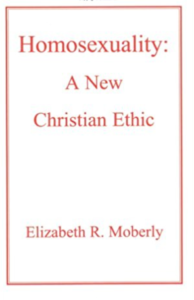 into the translation notes on the Revised Standard Version (RSV) of the Bible (1947 NT, 1952 full Bible). It was in the RSV that the word "homosexual" appeared for the first time in any translation, or in any Bible. Out of the findings from that investigation, I began to consider a deeper question: going forward from 1952, as we knew better about human sexuality, did we in the Christian church do better in revisiting original translation assumptions in key verses involving same-sex behavior?
into the translation notes on the Revised Standard Version (RSV) of the Bible (1947 NT, 1952 full Bible). It was in the RSV that the word "homosexual" appeared for the first time in any translation, or in any Bible. Out of the findings from that investigation, I began to consider a deeper question: going forward from 1952, as we knew better about human sexuality, did we in the Christian church do better in revisiting original translation assumptions in key verses involving same-sex behavior?
In doing ongoing research for my next book, particularly interesting puzzle pieces frequently come together that are worth sharing.
Chapter 15 will examine the response of the conservative Christian community to homosexuality. The responses have run the spectrum from reparative therapy to a demand for lifelong celibacy, while in other faith groups, the response has been full acceptance of homosexuality as a normal part of human sexuality viewed the same as heterosexuality.
To understand the ongoing demand from some segments of the Christian community for reparative therapy on LGBTQ people, one must go back to Sigmund Freud’s theories about homosexuality.
In 1896, Freud founded a new strain of psychology, talk therapy, and called it psychoanalysis. He related a variety of mental illnesses to his theories of missed or distorted childhood psychosexual stages. Most mental illnesses, he speculated, began with sexual abuse, fear of sex, or guilt about sex. Though his theories were baseless, they caught on, partly due to the scandalous intrigue they held for a culture emerging from the sexually repressed Victorian Era.
Beginning in the 1920s, there came a wider recognition of people who were exclusively same-sex attracted. Freud was bound to associate the observed same-sex behavior with disrupted childhood psychosexual stages, and he did. He thought the “mental illness” of both lesbians and gay men was due to disrupted childhood psychosexual stages. He believed homosexuality was an incomplete form of “normal” childhood heterosexual development that was neither a vice nor an illness.
A contemporary of Freud’s, Sandor Rado, also believed the only healthy outcome of human sexual development was heterosexuality. Rado believed homosexuality was a sickness caused by phobic avoidance by a child of the opposite-sex parent. Like many of his contemporaries, Rado had theories, formulated without the benefit of science and based on his limited work with extremely small client bases. It was Rado who first introduced the possibility of change or “reparative adjustment.”
Freud, however, by the end of his life, softened his views on homosexuality as an illness in need of fixing. In 1935, a mother wrote to Freud for advice about dealing with her homosexual son. Freud wrote back that homosexuality “cannot be classified as an illness; we consider it to be a variation of the human function,” adding that a change to heterosexuality was not possible.
A more complete understanding of how homosexuality came to be understood as a mental illness before it was depatholigized in 1973 according to the American Psychology Association (APA) is a long story that is well covered in this previous post, and in Chapter 2 of my first book, Walking the Bridgeless Canyon.
So, how did it come to be, beginning in the 1980s, that homosexuality’s next transition from its depatholigized (no longer a mental illness) status to a “sin” that could be fixed with Christian counseling? Or, more precisely, how did Rado’s already discredited reparative adjustment theory get resurrected from the dustbin of medical history into a Christianized version called “reparative therapy”?

Dr. Elizabeth Moberly
That story begins with Elizabeth Moberly.
Moberly appears to be the first person to construct theories using a Christian bent to “fix” a person’s non-heterosexual orientation, or even their gender identity. As important as Moberly seems to be in the history of reparative therapy, we should look at her qualifications as an expert in human sexuality, and in orientation change theory in particular.
There is surprisingly little information about Moberly. Information on her birth year, place of birth, educational history, and current status are all quite sketchy. What I present is what I could glean from her writings, other research, and exchanges with people who have worked with her.
In 1983, Moberly authored a 56-page book entitled “Homosexuality: A New Christian Ethic” (The Attic Press, Inc., Cambridge, UK), which “attempts to correlate the insights of psychology and of theology, in order to suggest what healing can mean for the homosexual and how it may be achieved.” (Preface)
The extent of her research in creating her book was to read: Freud (who, recall, by the end of his life said homosexuality existed along the natural spectrum of human sexuality); Irving Bieber, who wrote a book of his "research" in 1962 and himself used information from less than a dozen gay men over a period of thirty years from within his therapy practice as his sole information; and Edmund Bergler, who was utterly disavowed at the end of his life by the APA for cruelty and shameful treatment of his gay clients. This shortlist of contributors became Moberly's expert base.
Moberly did no original research with any with gay, transgender, or transexual (her terminology) people. Though she formulated theories; her work was never reviewed or accepted by a peer group of mental health professionals.
While many of the pre-Moberly theories about what caused homosexuality focused on Freud’s original emphasis on the smothering mother and the distant father dynamic, or centered on destructive or harmful relationships with the opposite sex parent, Moberly’s work had a different take.
She theorized that those who are homosexual suffer “from some deficit in the relationship with the parent of the same sex; and that there is a corresponding drive to make good this deficit—through the medium of same-sex, or ‘homosexual’ relationships.” (p. 2, “Homosexuality: A New Christian Ethic”) So, Moberly theorized, “What the homosexual seeks is the fulfillment of these normal attachment needs, which have been abnormally been left unmet in the process of growth.” (p. 9) “Transsexualism is the most marked degree, but far more commonly homosexuality implies a lesser degree of same-sex deficit.” (p. 13) So, according to Moberly, the same suggested treatment for the cure of homosexuality worked for the “extreme condition” seen in transexual people. (The term transgender was not in use when Moberly wrote her book, so her comments only referred to transexuals, who at the time were predominately seen as men who identified as women and were seeking medical assistance to modify their bodies. Ref. John Oliven)
Since “(h)eterosexuality it the goal of human development” (p. 23) and “God intended one heterosexual humanity” (p. 29) and homosexuality is “contrary to God’s intention” (p. 28), “(d)eliverance from the sexual expression of homosexuality needs is right and proper.” (p. 31)
Moberly, as Freud once had, viewed homosexuality as “essentially a state of incomplete development.” (p. 28) She writes that “(h)omosexual acts are prohibited, not because they repudiate the man-woman relationship, but because sexual expression is not appropriate to pre-adult relationships.” (p. 28) That’s interesting! In effect, children (homosexuals) should not marry adults (heterosexuals).
Moberly’s theories focus on various methods of healing damaged relationships with the parent of the same sex “through the medium of one or more non-sexual relationships with members of the same sex” (p. 42), thereby "maturing" the homosexual person to a fully heterosexual person.
Surprisingly, the tone of Moberly’s writings, though severely flawed and fully fabricated, is one of compassion. I would not have expected this until I read the book for myself. Those who met Moberly and worked with her speak of her as a good scholar and person of compassion.
Moberly first got on my radar two years when I was asked by a mother with a gay son to 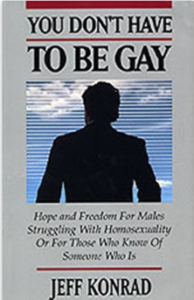 read and review You Don’t Have to Be Gay, written by “Jeff Konrad” in 1987. The mom found this book to be quite compelling in its message that gay men could indeed stop being gay and subsequently marry a woman. (My review of this book here.) Konrad, a publicly anonymous author, penned his book formatted as an exchange of letters between himself and “Mike.”
read and review You Don’t Have to Be Gay, written by “Jeff Konrad” in 1987. The mom found this book to be quite compelling in its message that gay men could indeed stop being gay and subsequently marry a woman. (My review of this book here.) Konrad, a publicly anonymous author, penned his book formatted as an exchange of letters between himself and “Mike.”
The writer constructs a series of letters written over a period of several years between himself, whom he calls “Bud” in the letters, and Mike. Bud writes to Mike about his journey of leaving a long-term same-sex relationship through healing from his homosexuality and going back to church.
Bud relies very heavily on the teaching and writings of Dr. Elizabeth Moberly and quotes her constantly as the expert who has informed him and guided him, and who can also help Mike.
Because Moberly’s name pops up as the expert in the early days of Christian reparative therapy writings frequently, she is an important figure to examine.
Yes, she was indeed a "doctor," but her doctorate appears to have been earned in theology from Oxford University in 1972.
She does not seem to have any training in psychology, yet Moberly’s writings have been and are still endorsed in Christian circles as “science.”
During the earliest years of her work, in the 1980s, people, gay people included, seemed quite receptive to Moberly’s theories. It moved conversations about homosexuality from the realm of sinful choices to something that was not the “fault” of the gay person and could even explain how they came to be homosexual.
In the words of Jeffry G. Ford who directly sought Moberly’s help for himself and his wife, “It (Moberly’s theories) seemed to offer a new ray of hope. To its credit, it took the emphasis off repression and sublimation and actually encouraged gay men to attempt to meet their ‘legitimate’ needs for same-sex love but always in ‘non-erotic’ ways.” (Personal blog post, 2000)
In the early years of the intersection of faith and sexuality, a widely distributed paper from Exodus International authored by Sy Rogers and Alan Medinger (1990) also cites Moberly’s work as authoritative. In fact, her work is still endorsed as such. Interestingly, this 1990 paper (without any citations) still resides on the Exodus International site as authoritative, even though Exodus Inc, a US-based umbrella organization for reparative therapy shut down in 2013.
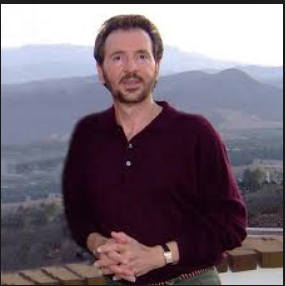
Dr. Joseph Nicolosi
The next push for the Christian reparative theory movement involves Dr. Joseph Nicolosi ( 1947-2017), a clinical psychologist, founder, and director of the Thomas Aquinas Psychological Clinic, and co-founder (with Charles Socarides) and president of the National Association for Research and Therapy of Homosexuality (NARTH) (1972).
As early as the late 1970s, Nicolosi called the offices of the newly created umbrella ministry Exodus wanting to advise and work with them in helping to "fix" homosexuals. Nicolosi and his methods were dismissed outright by Exodus staff at the time as junk science.
A few years later, Nicolosi was introduced to Moberly’s theories by a client. Nicolosi began to put Moberly’s theories to practice in the late 1980s.
Eventually, in early 1991, Nicolosi published his own book “Reparative Therapy” mimicking Moberly’s theories without properly and adequately citing her work.
Both Moberly and Nicolosi were featured and promoted speakers and advisors to Exodus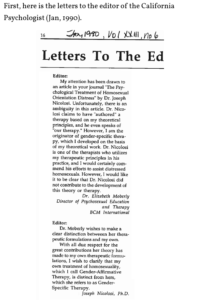 and at their annual conferences. The ongoing feud between Moberly and Nicolosi finally came to a head when both her book and Nicolosi’s book were endorsed and sold at a conference. Without resolution and in frustration over Exodus not picking one or the other, Moberly left the reparative therapy world, returned to England, and began to do work on alternative cancer treatments.
and at their annual conferences. The ongoing feud between Moberly and Nicolosi finally came to a head when both her book and Nicolosi’s book were endorsed and sold at a conference. Without resolution and in frustration over Exodus not picking one or the other, Moberly left the reparative therapy world, returned to England, and began to do work on alternative cancer treatments.
Since the early 2000s, it seems no one has been in touch with Moberly. Two of her former colleagues that I contacted believe when she left the ex-gay movement, she also disavowed her theories.
Tragically, in Moberly’s void, Nicolosi became the authoritative voice for reparative therapy. His tone and attitudes were markedly different than Moberly’s. Nicolosi pushed into the Christian world and preached the efficacy of reparative therapy, and consequently, it became the hope some sought for fixing LGBT Christians.
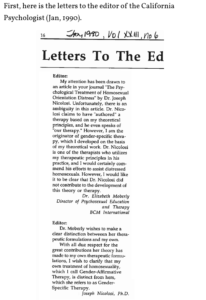 Nicolosi was a frequent speaker representing NARTH and his counseling practice at Exodus conferences, as well as for Focus on the Family’s ex-gay arm, Love Won Out. Though his theories and practices were widely disputed and challenged by professional medical associations and LGBTQ rights organizations, he remained a popular favorite of the conservative Christian community.
Nicolosi was a frequent speaker representing NARTH and his counseling practice at Exodus conferences, as well as for Focus on the Family’s ex-gay arm, Love Won Out. Though his theories and practices were widely disputed and challenged by professional medical associations and LGBTQ rights organizations, he remained a popular favorite of the conservative Christian community.
While there are still many conservative Christian denominations, churches, and leaders who expect LGBTQ Christians to seek reparative therapy (some have now “softened” the terminology to “sexual orientation change efforts” [SOCE]), others are opting for more “pastoral” approaches knowing that LGBTQ people are not changing their sexual orientation or gender identity. They’ve moved the goalposts of behavioral expectations from orientation change, or SOCE, whatever they choose to call it, to mandatory lifelong celibacy for LGBTQ Christians.
According to a study recently released in January 2018 by the University of California, Los Angeles School of Law, it is estimated that 20,000 LGBTQ youth from ages 13 to 17 will undergo conversion therapy from a licensed health care professional before the age of 18. Approximately 57,000 youth will receive treatment from a religious or spiritual advisor before they reach adulthood. About 698,000 LGBTQ adults in the U.S. have received conversion therapy at some point in their lives, including 350,000 as adolescents.
Nine states and Washington, D.C., along with 32 localities have laws protecting youth under age 18 from receiving conversion therapy (or SOCE) from licensed health care providers, thereby saving approximately 6,000 youth from ages 13 to 17 from conversion/reparative/change orientation therapy.
In closing, to review, from the 1920s till the 1970s, therapists thought gay people, then called homosexuals, could be cured of the mental illness of homosexuality. Then the therapist organizations realized, that without the benefit of research and with lack of knowledge, they made a grievous error—homosexuality was in fact not an illness, but part of the normal spectrum of human sexuality.
Then, a slightly tweaked variation of once-discounted therapy was introduced into the Christian community (by Moberly), again without the benefit of research. But this time, it was couched in sacred language with consequences lasting for eternity. Most of these orientation change advocates have also conceded are not seeing the results they had expected.
Now, some of them have moved from the need for orientation change to celibacy requirements. Are you seeing a cycle?
The premise of my next book continually asks the question “Since the 1940s, as we knew better, did we do better?”
As we knew better about human sexuality, were we (and are we) willing to challenge the assumptions that were made in the 1946 RSV translation on same-sex behavior? My research thus far proves we have done poorly with this issue as a whole.
Similarly, as we knew better about human sexuality, have we been willing to challenge foundationally flawed assumptions originating in the 1980s concerning Christian reparative therapy? On this topic, my research is again showing we have done poorly.
Reparative adjustment, introduced in the 1930s, was long ago found to ineffective and destructive. Similarly, Christian reparative therapy is also ineffective and destructive.
Books are published regularly demanding that gay and transgender people change for the sake of inclusion in the church.
We can keep lugging the behavioral expectation goalposts around while using them as a barrier to inclusion for LGBTQ people who want equal access to faith, or we can get serious about doing the diligent work of studying ancient texts in ancient contexts while simultaneously allowing the modern understanding of human sexuality to inform us.
While it is often difficult to challenge assumptions that we believe are rooted in truth, tradition, science, or the Bible lives really do depend on it.
**********
If any reader has current or additional and pertinent information on Elizabeth Moberly, please email me at: Kathy@CanyonwalkerConnections.com
